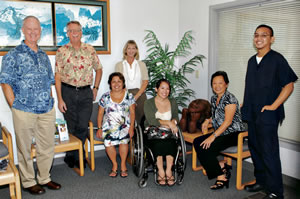National Hospice Month
Interviewed by Rasa Fournier
Wednesday - November 23, 2011
E-mail this story | Print this page | Comments (0) | Archive
 Del.icio.us Share
Del.icio.us Share

Dr. Geoff Galbraith
Medical director at Hospice Hawaii
Where did you receive your schooling and training?
I attended the University of Washington Medical School in Seattle and completed my internal medicine residency training at the John A. Burns School of Medicine. I am subspecialty trained in hospice and palliative medicine.
How long have you been practicing?
I’ve been practicing in Hawaii for 37 years.
Can you give an overview on your pediatric hospice program?
It is the first in Hawaii.
What makes Hospice Hawaii’s program unique is that we created a multidisciplinary team with a deep appreciation for communication skills. We assess the needs of parents and ask: What are the needs of parents who are experienced but have a child with a chronic illness that may result in death? How do we relate to the child first, as they are very different in their relationship with disease than adults are? How do we relate to the parents who have a complex psychosocial and emotional relationship with their children, and what about in the context of other children, or grandparents, sometimes great-grandparents?
What is palliative medicine?
Palliative medicine is the expert understanding and treatment of symptoms that are associated with chronic illness. Hospice Hawaii has expertise in treating symptoms, which can include emotional dejection: I’ve lost my will to go on. It can mean existential spiritual crisis: How could God do this to me?
Palliative medicine is a team-based approach organized around reducing suffering. Suffering is a human condition that is complicated. Sometimes people are suffering not for themselves but in their relationship with their spouse because they don’t want their spouse to continue to go through this.

|
A big difference in palliative medicine is there is no required projection of life span. Hospice is defined by a six-month prognosis and no curative treatment, palliative treatment only.
Can you talk about the latest insurance changes regarding the addition of curative treatment to end-of-life care?
With health care reform, children who receive Medicaid are able to have both curative treatment and hospice treatment simultaneously. We’ve discovered in national studies that when palliative care intervention is introduced along with curative treatment, patients and families are more satisfied. Patients experience less pain, less physical suffering and live longer. They also have fewer emergency room episodes and have much less intensive care at the end of their lives.
In Hawaii, the University Health Alliance now covers concurrent end-of-life care. So if we have a patient with late-stage cancer, they can have hospice care right from the beginning, working closely with the oncologist for curative treatment. Somehow in our cultural environment hospice care is associated with giving up care and giving up your relationship with your doctor. Hospice care no longer means that we’re not going to do anything therapeutic for you and that you have to give up. Studies also demonstrate that when people feel cared for and they’re in their home, as opposed to an artificial environment, they’re happier, more functional.
Before pediatric hospice care, where were children with lifethreatening illness traditionally treated?
Traditionally our youngsters have been cared for in the intensive care unit, in the hospital or in special facilities. We cared for a young lady last year whose entire life had been spent either in an intensive care unit or in a ventilator facility for youngsters. Introducing hospice gave her the chance to be at home for the first time. The intensive care physicians at Kapiolani ran the care. They would manage ventilator settings and changes in medication while we handled palliative medicine, whether it was symptom management, pain control, nausea or vomiting.
Hospice care always means team, so it’s the nurse case manager, the social worker and our nurse assistants. They’re in the home doing body care, which sometimes for adults is grooming, feeding, changing, bathing and helping families understand movement to optimize functional status. Social workers have the opportunity not just to work resources or manage placement, but also to actually do counseling. We have massage therapists who work with children and adults to provide physical therapy for rehabilitation. We have a wonderful art therapist. Art, painting and sculptures with children is very important in understanding their perception of their illness, their worldview, and their relationship with mom and dad.
At what point does a child begin receiving hospice care?
The key people are social workers who are case managers in the hospitals because they’re looking to see if the patient is no longer appropriate for acute care, and they look for available venues for those patients. Can they go home with the right support? Is this a hospital-eligible patient? So they’re developing knowledge around hospice eligibility.
The 1984 language that says hospice care is for patients who in the natural course of illness might die in six months is antiquated. We try not to scare patients by talking to them about six months. That’s between doctors and insurers. What we talk about is supportive care. We’re here as an added team support for your chronic illness care. We will talk about your values, your preferences. We’ll ask questions: Many patients in your situation have thought about dying, have you been thinking about it? And if you have thought about it, what are your thoughts? What are you imagining? How would you like that to be? Spiritually, what gives you strength? With this chronic illness, how do you persevere? What gets you down? Do you have spiritual support in your community?
Every hospice/palliative medicine team has the variety of expertise to reflect on these diverse needs. We’re looking at whole person values and living.
E-mail this story | Print this page | Comments (0) | Archive
Most Recent Comment(s):













